Introduction
There are 6 species of deer living in our English countryside. The only two species that are indigenous are the Red Deer and the Roe Deer. Deer are extremely stressful animals so if injured or trapped they can quickly go into a state of shock, especially if they overheat or struggle excessively, resulting in a life threatening condition known as capture or post capture myopathy. Due to their size and strength they are difficult animals to house and treat, so not all wildlife rescues are able to take them in. If you're walking in an area where you know deer are likely to be present, please ALWAYS keep your dog on a lead. This is particularly important during May and June when pregnant does and newborn fawns will be around. A loose dog can very easily chase a pregnant doe eventually causing her to miscarry, or inflict serious injuries and death to a newborn fawn as it lies hidden in the undergrowth. The deer species we see most frequently in Hertfordshire is the Muntjac. This small deer, which is now becoming widespread, was brought over from China to Woburn Park in Bedfordshire during the early 20th century. As a result Muntjac are very sadly becoming regular road traffic casualties, particularly during the darker winter months, when their peak movement activity is around dawn and dusk. Although sometimes seen in gardens during daylight hours, they're more nocturnal, particularly in built-up areas. Unlike the other species of deer Muntjac don't have a defined breeding season, and instead breed all year round, resulting in fawns being found in the middle of winter.
